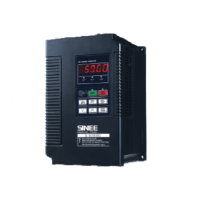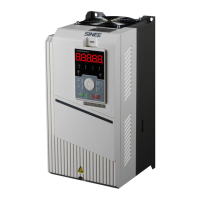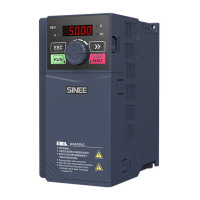User Manual
EM303A General Purpose Inverter
121
z Set F1-15=1, inverter performs stationary autotuning.
z Set F1-15=2, inverter performs rotational autotuning.
z It takes about 2 minutes to finish autotuning motor parameters, and the keypad
displays returns the initial power-on status.
z In autotuning, press STOP/RESET button to cancel autotuning, and inverter
will return parameter setting status.
z If autotuning fails, SrE (Stator Resistance Error) or SIE (Idling Current Error)
will trip, and then press STOP/RESET button, inverter will return to parameter
setting state.
8.4 Automatic Torque Boost and Slip Compensation
If the load increases, then the motor slippage increases, and motor speed drops.
Motor can keep constant speed with help of slip compensation and automatic torque
boost.
8.4.1 Automatic Torque Boost
Automatic torque boost F0-15=0, boost the output voltage automatically through
detecting load current. The scale of automatic torque boost is up to the voltagedrop
of motor stator resistance (F1-10) acquired by motor parameter autotuning. See
Figure 8-2 for the scale of automatic torque boost.
Figure 8-2 Automatic Torque Boost Scale Figure 8-3 Slip Compensation
8.4.2 Slip Compensation
In V/F control mode, the speed of motor rotor drops down as the load increases. To
ensure the speed of motor stator is closer to idling speed when motor is with rated
load. Slip compensation can be started, set it as per F3-30. Usually slip
compensation is not needed in vector control mode.

